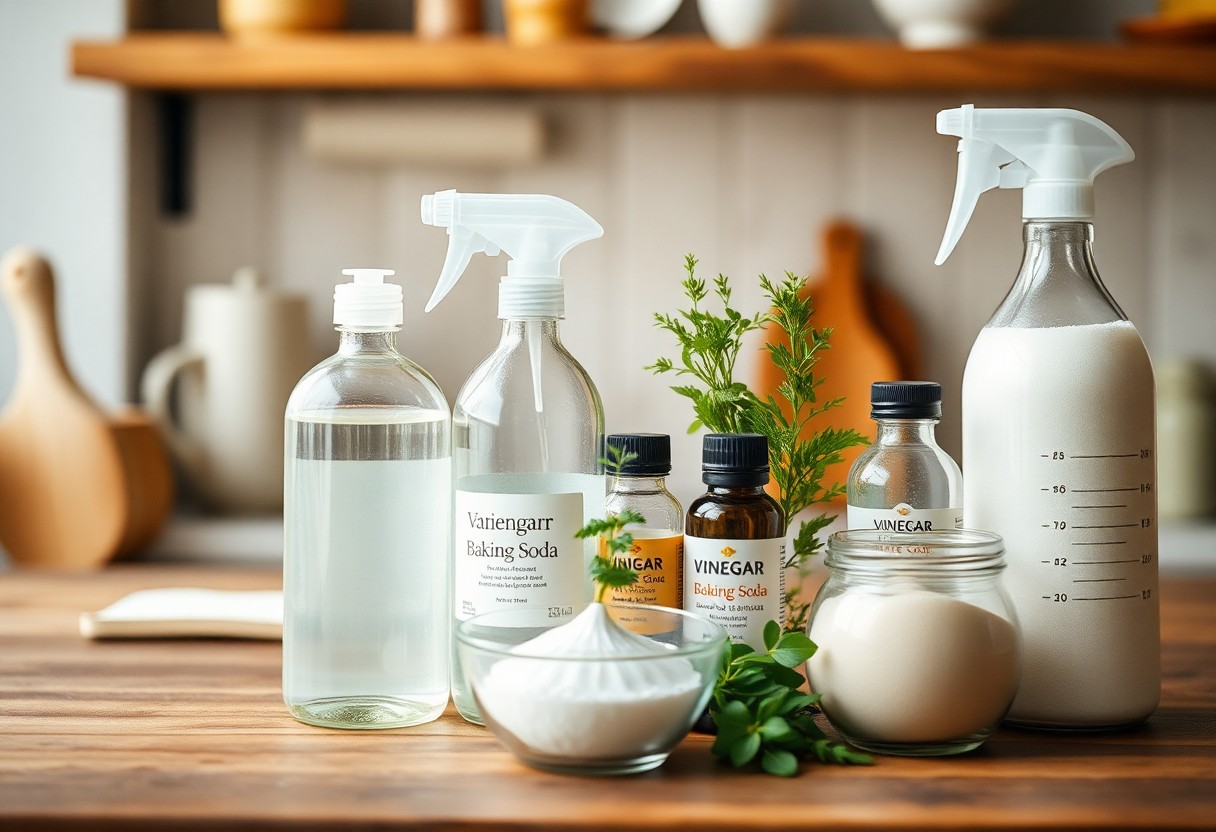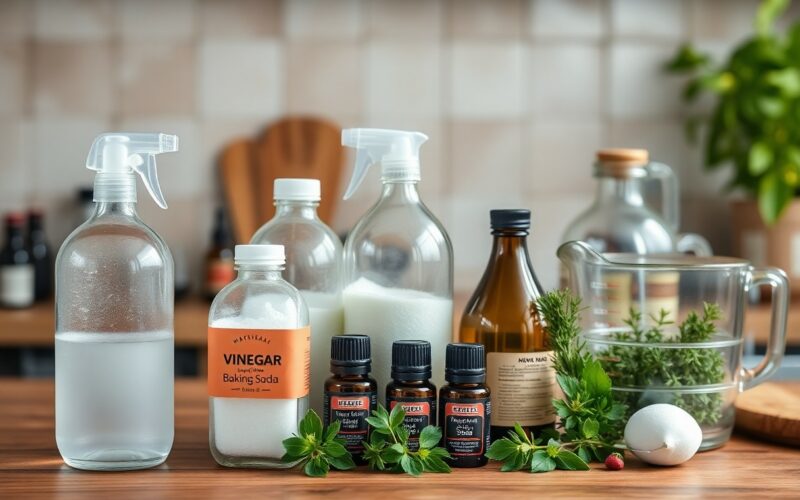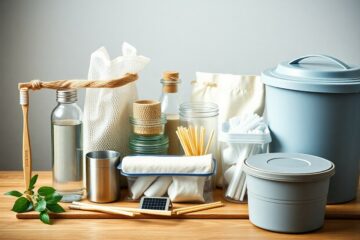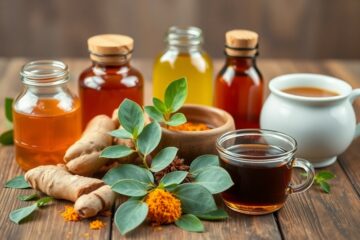Many people are becoming increasingly aware of the harmful chemicals found in conventional cleaning products and are seeking safer alternatives. By creating your own natural cleaning products, you can protect your health and the environment while saving money. In this guide, you will discover a variety of eco-friendly recipes that utilize simple ingredients found in your home. You’ll learn how to effectively clean your space without compromising on cleanliness or safety, ensuring that your home remains a healthy haven for you and your loved ones.

Table of Contents
Key Takeaways:
- Utilize common natural ingredients like vinegar, baking soda, and important oils to create effective cleaning solutions that are safe for the environment.
- Experiment with different combinations of ingredients to customize your cleaning products for specific uses, such as kitchen cleaners, bathroom disinfectants, or general surface cleaners.
- Store homemade cleaning products in clearly labeled containers to ensure safety and avoid confusion, while also keeping them out of reach of children and pets.
Understanding Natural Cleaning Products
The rise of environmental consciousness has led many households to reconsider their cleaning habits. You are likely aware that many conventional cleaning products contain synthetic chemicals that can be harmful to both your health and the planet. Natural cleaning products, on the other hand, utilize ingredients derived from nature to clean effectively without the side effects associated with traditional cleaners. By incorporating these eco-friendly options into your cleaning routine, you’ll not only enhance the air quality within your home but also contribute positively to the environment.
Benefits of Eco-Friendly Cleaning
Now, as you transition to eco-friendly cleaning products, you’ll appreciate the myriad of advantages they offer. Firstly, natural cleaners are often safer for your health since they typically contain non-toxic ingredients. This poses less risk for your family, pets, and the environment. Additionally, many natural ingredients, such as vinegar and baking soda, are known for their deodorizing and stain-fighting properties, proving that you don’t have to sacrifice effectiveness for safety. With less chemical exposure, you also reduce the risk of causing allergies or respiratory issues to sensitive individuals in your home.
Key Ingredients to Use
If you’re looking to create your own natural cleaning products, it’s necessary to know which ingredients to incorporate. The best eco-friendly cleaners often utilize common household staples like baking soda, white vinegar, and necessary oils. Baking soda acts as a gentle abrasive and deodorizer, while vinegar is effective for breaking down mineral deposits and cutting through grease. Essential oils, such as tea tree or lavender, not only provide a pleasant scent but also add antibacterial properties to your cleaning solutions.
With a few selected ingredients, you can create a range of powerful cleaning products that are as effective as their commercial counterparts. By choosing organic vinegar for its acidic properties and combining it with baking soda for scrubbing power, you can tackle a multitude of tasks around your home— from disinfecting surfaces to tackling stubborn stains. Furthermore, necessary oils not only enhance the efficacy of your mixtures but also allow you to customize your scent, creating a refreshing and inviting atmosphere without the worry of toxic fumes.

How to Make Basic All-Purpose Cleaner
If you are looking for an effective and safe way to clean your home, a homemade all-purpose cleaner is an excellent choice. Not only does it help reduce your environmental footprint, but it also eliminates the need for harsh chemicals found in commercial cleaners. With just a few simple ingredients, you can create an all-purpose cleaner that is effective on a variety of surfaces while being gentle on the planet and your health.
Ingredients and Tools Needed
The first step in creating your all-purpose cleaner is to gather the necessary ingredients and tools. You will need:
Ingredients and Tools
| 1 cup distilled white vinegar | Essential for cutting through grease and grime |
| 1 cup water | Essential for diluting the vinegar |
| 10-20 drops of imperative oil (like lemon or tea tree) | Provides a pleasant scent and adds additional cleaning properties |
| Spray bottle | For easy application |
Step-by-Step Instructions
Any DIY project can be simplified into clear steps, and making your all-purpose cleaner is no different. Follow these straightforward instructions to whip up your eco-friendly cleaner:
Instructions
| Combine the water and vinegar in a spray bottle. | This forms the base of your cleaner. |
| Add the imperative oil drops. | This enhances both cleaning power and scent. |
| Cap the spray bottle and shake gently. | This mixes your ingredients thoroughly. |
| Label your bottle for future use. | Ensure safe and easy identification. |
Make sure you test your all-purpose cleaner on a small, inconspicuous area of your surfaces before widespread use. This ensures no adverse reactions occur. Your cleaner is ideal for countertops, sinks, and other household surfaces, but avoid using it on natural stone, as the vinegar can be overly acidic and may damage the surface. Additionally, always keep your cleaner out of reach of children and pets, ensuring safety while maintaining a clean, eco-friendly home.

How to Create Specialized Cleaners
Keep in mind that creating your own specialized cleaners can be a simple yet effective way to address specific cleaning challenges. By using environmentally friendly ingredients for DIY cleaning recipes, you can formulate your own solutions tailored to various surfaces and issues around your home. From tackling windows to disinfecting bathrooms, these customized cleaners can help you maintain a fresh and clean environment without exposing your family to harsh chemicals. Below, you’ll find two effective recipes: one for glass cleaning and another specifically for bathroom disinfecting.
Glass Cleaner Recipe
With just three simple ingredients, you can create an effective glass cleaner that streaks and smudges won’t stand a chance against. Combine equal parts of distilled water and white vinegar in a spray bottle, adding a few drops of natural dish soap to enhance the cleaning power. Shake well to mix the ingredients before use. You’ll be amazed at how well this solution cuts through grime and leaves your windows and mirrors sparkling clear. Just spray the solution onto the surface and wipe away with a microfiber cloth for a perfect finish.
Bathroom Disinfectant Recipe
The bathroom is one of the most frequented areas in your home, and keeping it free of bacteria and germs requires a reliable disinfectant. To create your own, mix 1 cup of water, 1 cup of white vinegar, and 10-15 drops of tea tree oil in a spray bottle. The tea tree oil not only adds a pleasant fragrance but is also known for its antimicrobial properties, making it highly effective against common bathroom germs. Shake the mixture before each use, spray on surfaces like countertops, sinks, and toilets, and wipe down with a clean cloth or sponge. This natural disinfectant will keep your bathroom fresh and clean without the need for harsh chemicals.
Bathroom cleaning can often feel overwhelming, but using this simple disinfectant recipe means you can do your part for your family’s health without compromising on cleanliness. The combination of vinegar and tea tree oil not only fights mold and odor but is also a safe alternative for homes with children and pets. When you’re ready to tackle bathroom germs, this eco-friendly solution will ensure you achieve impressive disinfecting results while being conscious of the ingredients used.
Tips for Using Natural Cleaning Products
Now that you’ve crafted your own natural cleaning products, it’s important to utilize them effectively to maximize their benefits. Keep in mind the following tips:
- Ensure that your cleaning products are stored in properly labeled glass or stainless steel containers.
- Always test a small area before applying any mixture to ensure it doesn’t damage your surfaces.
- Combine your products with hot water when applicable for enhanced cleaning power.
- Use microfiber cloths or natural sponges to aid in the cleaning process.
- Ventilate the area you are cleaning to improve air circulation.
After you’ve implemented these tips, you’ll likely find that your natural cleaning solutions work just as effectively as store-bought options, all while being kind to the planet.
Best Practices for Effectiveness
On your journey towards a greener home, it’s wise to adopt some best practices for using your natural cleaning products. Firstly, consistency is key; using the products regularly will create less buildup and make cleaning easier over time. Additionally, make sure to follow the recommended ratios of ingredients in your recipes, as too much acid or base can lead to less effective cleaning.
Additionally, you may want to pair your cleaning routine with a decluttering process. Less clutter means fewer items you have to clean around, allowing your natural cleaning products to shine more effectively. This synergy between decluttering and cleaning will create a more harmonious and functional space for you.
Safety Considerations
Safety is paramount when using natural cleaning products, even though they tend to be less hazardous than conventional cleaners. When you combine ingredients, it’s important that you use them in their recommended proportions to avoid any unexpected reactions. Always wear gloves to protect your skin, and if you are using important oils or strong acids, such as vinegar, use caution to prevent irritation.
To improve your safety practices, always ensure that the cleaning area is well-ventilated, especially when using products that contain strong scents. While natural products are generally safe, some important oils can be toxic if ingested or if they come into contact with sensitive skin. It is advisable to keep all cleaning products out of reach of children and pets to prevent accidental exposure. Additionally, keep an eye out for any allergic reactions, as some natural ingredients can cause irritation for certain individuals.
Factors to Consider When Switching to Natural Cleaners
Unlike conventional cleaning products that often contain harsh chemicals, switching to natural cleaners requires you to consider several important factors. Making this transition can enhance your home and your impact on the planet. Here are some aspects to reflect on:
- Effectiveness of the natural solution
- Availability of ingredients
- Personal sensitivities to certain ingredients
- Cost relative to your current cleaning products
After taking these factors into account, you may find that Green Cleaning Recipes offer effective alternatives that align with your values and needs.
Cost-Effectiveness
An important aspect to consider when switching to natural cleaners is their cost-effectiveness. Natural ingredients such as vinegar, baking soda, and imperative oils are often much cheaper than commercial products filled with chemicals. When you start to create your own cleaning supplies, you may notice that the initial investment in these raw materials pays off over time. Many common household items can double as cleaning agents, reducing the need for multiple specialized products.
In addition, buying in bulk can lower costs further, as you’ll likely find significant savings by purchasing larger quantities of staples like vinegar or baking soda. This means not only do you save money, but you also gain the satisfaction of contributing to a healthier environment without breaking the bank.
Environmental Impact
Consider the environmental impact of your cleaning choices. Natural cleaning products are often more biodegradable and less toxic, reducing their effect on ecosystems when they are washed down the drain. By choosing eco-friendly ingredients, you help decrease harmful pollutants that can disrupt aquatic life and soil health, making a significant difference for our planet.
Understanding the dangers associated with conventional cleaning products extends beyond personal health; the vast quantities of chemicals entering our water systems can have dire consequences. Many commercial brands contain aerosol propellants, phosphates, and synthetic fragrances that not only endanger wildlife but also contribute to indoor air pollution. In contrast, natural cleaners often use plant-based ingredients which are safer for you and your family while being less harmful to the environment. By opting for homemade cleaning products, you actively participate in reducing your ecological footprint and promoting a greener planet.
Maintaining a Clean and Green Home
Not only does a clean home create a soothing environment, but your choice of cleaning products can also impact your health and the planet. By integrating your natural cleaning products into a consistent cleaning routine, you can ensure that your home remains both tidy and eco-friendly. Establishing a schedule for cleaning tasks can help you stay on track and minimize the build-up of dirt and grime. This can include daily, weekly, and monthly tasks that you conveniently incorporate into your lifestyle.
Routine Cleaning Tips
While implementing an eco-conscious cleaning routine, it’s important to set achievable goals that align with your personal schedule. Here are some tips to help you maintain that balance:
- Designate a specific cleaning day each week to focus on deep cleaning areas like your kitchen and bathrooms.
- Use your homemade natural cleaners daily to tackle common spots, like counters and spills, preventing larger messes.
- Encourage everyone in your household to participate in cleaning chores, fostering a sense of shared responsibility.
- Incorporate a brief daily tidy-up session to keep clutter at bay.
- Choose a green cleaning method, such as microfibers or steam cleaning, to reduce waste and maximize effectiveness.
Any eco-friendly cleaning habit you instill today will pay off tomorrow, contributing not only to a pristine home but also to a healthier environment.
Storage and Organization
While maintaining a clean and green home is important, proper storage and organization of your cleaning supplies is equally important. Efficient storage helps reduce clutter and ensure that all your natural cleaning products are easily accessible when you need them. Locate a specific area for your cleaning supplies, such as a dedicated cabinet or a caddy, to keep everything organized and out of the way.
With the right storage solutions, you can effortlessly manage your homemade cleaning products. Consider using glass containers with labels to store your solutions, as they not only look appealing but also ensure safety by clearly indicating the contents. Avoid using plastic containers, as harsh ingredients may leach into your cleaning solutions, posing a risk to your health. Additionally, ensure that any important oils or potent ingredients are out of reach of children and pets to maintain a safe environment. By staying organized, you’ll not only streamline your cleaning process but also uphold the integrity of your eco-friendly practices.
Summing up
Hence, creating your own natural cleaning products not only empowers you to take control of the ingredients in your home but also contributes to a healthier environment. By utilizing simple and eco-friendly recipes, you can effectively clean your living space without exposing yourself or your family to harsh chemicals. As you incorporate these homemade solutions into your routine, you’ll likely find that they are just as effective as conventional products, often at a fraction of the cost.
As you explore the various recipes and techniques, you will develop a deeper connection to the processes that maintain your home’s cleanliness. This journey to sustainability encourages you to be more intentional about your consumption habits while promoting a safer space for both you and the planet. By adopting these practices, you contribute to a growing community of environmentally conscious individuals, demonstrating that small, thoughtful changes can lead to a significant collective impact.
FAQ
Q: What are the benefits of using natural cleaning products?
A: Natural cleaning products are often safer for your health and the environment compared to conventional cleaners. They are typically made from biodegradable ingredients, which means they break down more easily and do not contribute to pollution. Additionally, they are less likely to cause allergic reactions or irritate sensitive skin, making them a gentler option for households with children or pets.
Q: What are some common ingredients used in DIY cleaning products?
A: Some popular ingredients for making your own natural cleaning products include vinegar, baking soda, lemon juice, castile soap, crucial oils, and hydrogen peroxide. These ingredients possess natural cleaning properties, such as disinfecting, deodorizing, and cutting through grease, while being gentle on surfaces and safe for the environment.
Q: How do I make an all-purpose cleaner from natural ingredients?
A: To make an effective all-purpose cleaner, mix equal parts of water and white vinegar in a spray bottle. You can enhance the scent and cleaning power by adding a few drops of crucial oils, such as lemon, tea tree, or lavender. Shake well before using, and spray on surfaces before wiping with a clean cloth. This solution is great for kitchens, bathrooms, and other home areas.
Q: Are there any surfaces that I should avoid using natural cleaning products on?
A: While many natural cleaning products are safe for various surfaces, it’s advisable to avoid using vinegar on natural stone surfaces like granite or marble, as it can etch and damage the stone. Additionally, avoid abrasive powders like baking soda on delicate surfaces to prevent scratching. Always test a small, inconspicuous area first when trying out a new homemade cleaner.
Q: How can I store and preserve my homemade cleaning products?
A: To store your homemade cleaning products, use labeled glass or plastic containers with airtight seals. Keep them in a cool, dark location to prolong their effectiveness. Most natural cleaning mixtures can last up to 2-3 months, but it’s a good practice to check for any changes in smell or appearance before use. Always label each container with the contents and date to help keep track of freshness.

Our contributing author is a passionate advocate for eco-friendly living and sustainability. With a background in eco-life, they are dedicated to inspiring and empowering individuals to adopt environmentally conscious lifestyles. Through insightful articles, they share practical tips, innovative solutions, and thought-provoking perspectives to promote a greener, more sustainable world. Join them on the journey towards eco-smart living and discover how small choices can make a big impact. 🌱








